R Boat Pirate is Best Existing Example
Of the R-Boat Racing Class
Extensively Restored, She’s Now an Exhibit at The Center for Wooden Boats
Presently owned by The Center for Wooden Boats, and fully restored from 1999 to 2005, R-boat Pirate is the best existing example of the R-class. Constructed in 1926 by Lake Union Dry Dock of Seattle, Washington, from plans by L.E. “Ted” Geary, Pirate embodies the pinnacle of yacht design and construction in the Seattle area in the early 20th century. The sloop won the National Championship in its class in 1929 and has the reputation of being one of the fastest R-boats ever built.
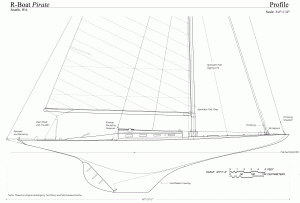
Pacific coast R-boat racing began in Seattle in 1913 when Sir Thomas Lipton donated a lavish silver cup to be the prize for the class. The following year, after defeating would-be American defenders Spray and Defender, Ted Geary’s Sir Tom (so named to honor the cup’s donator) dominated Turenga from Royal Vancouver Yacht Club to capture the cup. Geary and Sir Tom went on to win the Lipton every year until 1928.
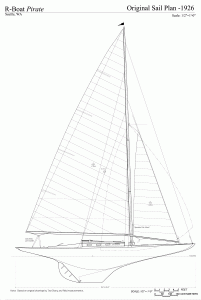
In the spring of 1925, yachtsman Don Lee of Los Angeles challenged his son Tommy to win the Pacific Coast Star Championship with the promised prize of a new R-boat. Tommy Lee sailed his Star Satellite to victory at the Pacific Coast Yachting Association (PCYA) regatta in Victoria, British Columbia, and true to his word, Don Lee commissioned Pirate for his son.
On April 10, 1926, R-boat Pirate was christened and launched on Lake Union.
Pirate became the subject of a unique program in 1927 when the Hearst newspapers commissioned Ted Geary to adapt the R-boat design to a scale model for schoolboys to build and race. Regattas using the model R-boats were held at Westlake (now MacArthur) Park in Los Angeles and Seattle’s Green Lake. “Pirate Pond Boats” are still built and raced at The Center for Wooden Boats.
In 1928, Tommy Lee sold Pirate, leading to a long line of owners ending in 1999 when she was donated to The Center for Wooden Boats, which launched a six-year restoration project. Currently, the boat serves as an active, floating exhibition.
After restoration, Pirate was been measured for rating by an official and has been certified to be in-class. The vessel’s calculated minimum displacement under the rule is 10,850 pounds. When weighed on a certified digital scale, the vessel was 10,900 pounds – just 50 pounds overweight after 83 years. This is due to the restoration process keeping true to the original design scantlings.
Quoting from the report “Construction Details – R Class Sloop Pirate” which gives the original as drawn (1925) details along with notes on details, fasteners, and exceptions as found during the restoration process from 1999-2005:
The Hull:
The double-planked hull is 5/8” Burma Teak over 5/16” Western red cedar. The outer layer laps over the interior seams and is set in white lead paste. The planking fasteners are square black-iron boat nails. Each inner plank is back-screwed to the outer skin with two brass #8 x 7/8″ round head slot screws in the bays between the frames.
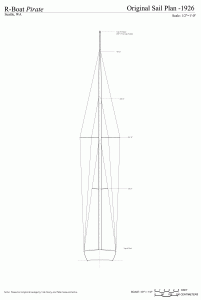
The majority of the frames are steam-bent white oak that is 1- 3/4” x 1- 7/8″ beveled square to the centerline and gradually tapered from the bilge stringer to the clamp. Every third frame is sawed and doubled white oak, each piece measuring 1″ x 1- 3/4″. In the way of the mast and chain plates, all the frames are the “double-flitch” type. All frames are secured to the clamp with 1/4” black-iron machine screws, with nuts and washers on the interiors. Each frame is boxed into the keel and bolted to sawed teak floor timbers. The primary structural members are two Douglas fir beams that form the keelson (11″deep, sided 11′) and the horn timber. The horn timber (11″ deep, sided 11″) laps onto the keelson, and the joint is strengthened by a long flat knee fastened by long black-iron drifts and lag screws. This joint is stiffened by the teak deadwood and rudder post aft. There is a small teak stem and cambered teak transom. The centerline is rabbeted over the full length to take the planking.
There is a small teak furring piece at the forward end of the ballast keel to fair into the centerline.
The clamp and shelf are continuous pieces of Douglas fir. The shelf is 3/4” thick and edge-fit, measuring 3″ wide at station 5, tapered fore and aft. The shelf is secured to the clamp (4″ x 1- 1/4”) by 1/4” iron machine screws and tapered fore and aft.
The stringers are 34′ long, clear, continuous Douglas fir, as drawn in the original construction plans, that measure 2″ x 4″ at their deepest and taper fore and aft. They are secured to the frames with 1/4” black-iron machine bolts with square nuts.
The mast step is teak and was sawed and built true to the construction plan, fastened with transverse 5/16″ iron carriage bolts. A 1926 silver “Peace” dollar was found in the step.
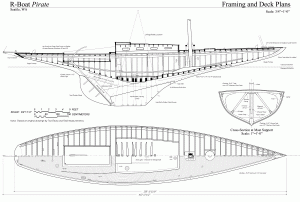
The Deck:
The teak sawed deck beams are 1- 7/8″ deep and sided 1- 1/4” to a constant camber. Each is bolted onto the shelf with two black-iron machine screws with the nuts under. Hanging knees, grown apple crooks, bolt to the beams and frames at the partners and both ends of the deck house.
Teak carlins define the cockpit, house, and foredeck hatch profiles. Short deck beams are boxed into the house and hatch carlins. The cockpit margins have small shelves on which the short beams land.
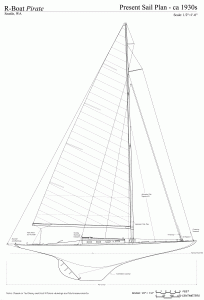
The original construction drawing is vague with regard to the decking. A l”-thick structure of some composition is indicated, but there is no written reference. By 1999, Pirate had a 3/4” teak deck fastened to the deck beams with #8 x 1- 1/4″ bronze flathead screws. The planks were 2″ wide with chamfered edges that formed a groove. There was no caulking. This decking appeared to be 30 to 45 years old. More recently, a 1/4”-thick plywood skin was installed over the flooring compound and fastened with stainless-steel screws. Heavy teak covering boards may have been added at the same time. After this was removed, the heavily-rusted remnants of black-iron nails were found in the deck beam tops. This suggests that the beams were probably original and an earlier deck had been replaced at some time.
When the interior trim was removed, a spacer of some kind was evident between the carlin tops and the bottom edges of the house sides. This was later discovered to be two 1/4” skins of red cedar laid “double diagonal” style. The earliest photographs of Pirate show teak decking bent parallel to the deck profile with covering boards and a king plank.
Evidence indicates that the deck house was built on top of the sub-deck with the teak laid up next to it. This ascertains the original composite: 1/2” subdeck of two skins of red cedar with 3/8″ teak overlay to the class scantling rules. The added stiffness of this structure allowed the builders to omit the lodging knees indicated in the original drawing. There was no evidence of them on the deck beams.
The deck house faces are single pieces of 1″ teak with teak corner posts. Early photographs of the boat indicate that the smaller square hatch in the drawing was not built. Likewise, the two small beams drawn in the sliding hatch cover appear to have been a drafting error. The window profiles taper as they go forward. The opening port lights in the forward face appear in the earliest photographs. The opening port in the house top just ahead of the companionway is original. The teak housetop beams have been sawed to a changing camber, 1-1/4” deep sided, and set into notches on the house sides.
The house top is 5/8” thick, double-diagonal planked red cedar fastened to the beams with boat nails. Painted cotton deck-grade duck canvas covers the housetop planking. The edges of the duck canvas are secured under broad, raised teak boards that form a handrail on all four sides, which were extant in 1999.
A lightly-built teak frame forms the cockpit with sides of 5/16” solid red cedar reinforced locally. The cockpit sole sits on 3-1/2” x 1″ beams and is planked with 3/4” red cedar with splined seams. The canvas duck covering is painted with the edges drawn up under the teak trim pieces.
Archived photographs from 1926 to 1929 show deck hardware consistent with the construction drawings. A 1926 advertisement featuring Pirate’s suppliers listed Merriman Bros, of Boston as the hardware vendor. The advent of Genoa jibs, symmetrical spinnakers, and the new “diamond” rig radically altered the way successful racers were sailed and equipped. Owners of earlier craft were forced to adapt their boats to the new way if they hoped to be successful in the 1930s. Halyard and sheet winches were added along with two-ended spinnaker poles and their gear. By 1999, very little of Pirate’s original deck hardware remained. The extant fittings included the forestay “comb,” opening port light in house top, lO’-long x 1- 1/4”-wide bronze flat tracks, cast bronze builder’s plaque, and bronze master partner brackets. All but the last item also showed evidence of nickel plating.
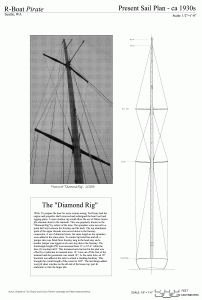
Rig and Sails:The 50′-long, hollow Sitka spruce mast was blocked solid at the partners, gooseneck, and masthead. The maximum diameter of 6″ at the deck, per class rules, tapered to 2-1/2” at the top. Period photographs show the mast stayed as drawn, using soft eyes and chocks, but the 1934 “diamond” rig stayed using stainless steel cable and rotary swaged terminals pinned to bronze mast tangs. The spar in Pirate was confirmed by Norman Blanchard and Sir Tom crewman John Kelly to be the final rig in Geary’s legendary R, Sir Tom, cut up in a Duwamish River boat yard in the early 1960s.
The spreader profiles, jumper strut, and head stay strut are correct to the 1934 re-rigging. The boom is solid Sitka spruce with twin bridles for sheet blocks and a sliding outhaul car aft. The universal pivoting swiveled bronze gooseneck, secured to the mast with bronze bands, is original to the mast. It is from Pigeon Hollow Spars of Boston. A Merriman Bros. No. 1 outhaul winch is mounted on the starboard side with a handle stowed on the aft side of the mast just above the deck level. The hollow Sitka spruce Spinnaker pole is just over 13′ long per the Rule formulae, with replica end fittings.
From the summer through the winter of 2009, The Center for Wooden Boats documented R-Boat Pirate through a grant from 4Culture. The documentation produced will be used to create a new interpretation exhibit on-site to emphasize the center’s mission to interpret Northwest small craft history. In addition, this project fits into CWB’s broader vision of becoming a regional documentation center affiliated with the National Park Service. The primary consultant to this project is Todd Croteau, HAER Maritime Program Coordinator. The project director is Heron Scott, CWB’s Lead Boatwright, with assistance from CWB staff members Shelly Leavens and Andrew Washburn. Volunteers involved in the documentation include Tim Barney, Scott Rohrer, David Kennedy, and Paul Marlow. Bob Boyce produced LIDAR scans of the vessel. The drawings were developed using a combination of digital survey data, hand measurements, and historic drawings and photographs.
To support the Center for Wooden Boats, click here.
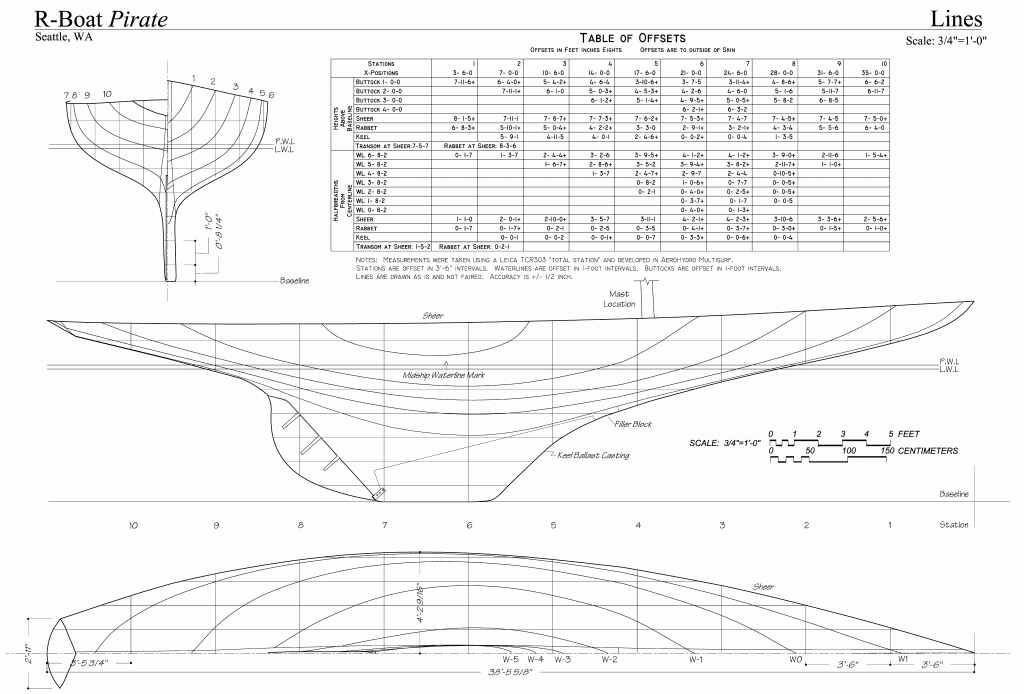
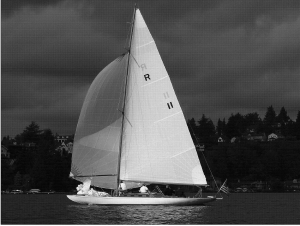
These images are no longer viewable. Did something break on your web site?
https://www.themodelshipwright.com/news/wp-content/uploads/2013/09/r_boat_pirate_plan_lines.gif
https://www.themodelshipwright.com/news/wp-content/uploads/2013/09/r_boat_pirate_plan_sail_present.gif
https://www.themodelshipwright.com/news/wp-content/uploads/2013/09/r_boat_pirate_plan_profile_ib.gif
Or could you send me new links to them?
Try right-clicking on the image and choosing “save as” to save them to your computer, and then open them as local files. I downloaded them and opened them with GIMP, a free photo editing software program, and they worked OK. Some internet browsers have trouble displaying such large images.
Thank you, that worked. So did “save target as”. Once I saved the images I was able to open them.
[…] a change of pace from our ship plans, we’ve put up construction drawings for the R-class sloop Pirate. Presently owned by The Center for Wooden Boats, R-boat Pirate is the best existing example of the […]
[…] Pirate under sail on Lake Union,Seattle. Photo by Karen Rohrer, 2010. […]